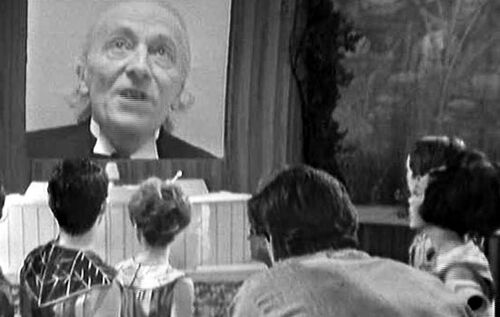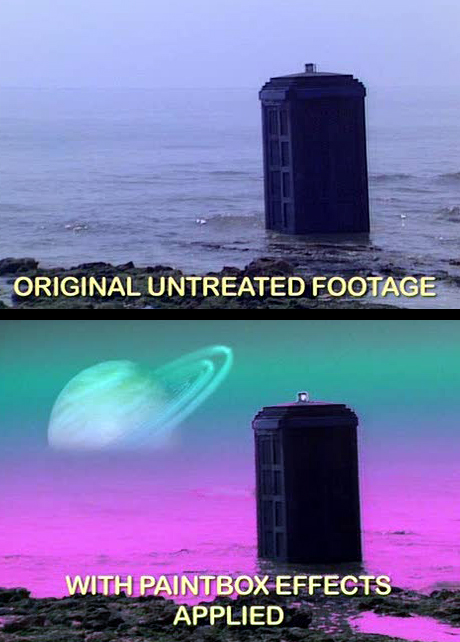Transmat:Doctor Who: Difference between revisions
No edit summary |
No edit summary |
||
| Line 11: | Line 11: | ||
<div class="tr-box one"> | <div class="tr-box one"> | ||
{{thead|Industrial action}} | {{thead|Industrial action}} | ||
[[File:Paintbox.jpg|link=http://tardis.wikia.com/wiki/Transmat:Doctor_Who?file=BBC%2527s_Historic_Mainframe_Arrives%2521%2521_%2528Quantel_Paintbox_DPB_7000%2529_This_created_many_80s_programs%2521%2521]] | |||
{{tcap|Click for a video of a [[21st century]] geek as he takes delivery of one of the two Paintboxes used by the BBC in the 1980s}} | |||
The '''[[Quantel Paintbox]]''' was a graphics workstation that allowed ''[[Doctor Who]]'' to have a primitive form of [[colourist|colour grading]] in the [[1980s]]. To find out more about the "business of show", go to '''[[:category:production information]]''', where you can read about [[colour separation overlay]], [[low loader]]s, [[telerecording]]s, [[vidFIRE]], [[rostrum camera]]s, [[2" quad]] tape, [[Ealing Studios]] and tons more.</div> | The '''[[Quantel Paintbox]]''' was a graphics workstation that allowed ''[[Doctor Who]]'' to have a primitive form of [[colourist|colour grading]] in the [[1980s]]. To find out more about the "business of show", go to '''[[:category:production information]]''', where you can read about [[colour separation overlay]], [[low loader]]s, [[telerecording]]s, [[vidFIRE]], [[rostrum camera]]s, [[2" quad]] tape, [[Ealing Studios]] and tons more.</div> | ||
<div class="tr-box two"> | <div class="tr-box two"> | ||
Revision as of 01:30, 11 October 2013
Playback was a television production technique in which pre-recorded material was literally played into a scene, rather than being added as a post-production effect. It was universally used in the 1960s as the method by which actors were seen on view screens. As seen in the picture at the left, William Hartnell was pre-recorded separately, then projected live into the scene with the actors in the foreground. Though antiquated, the technique was used even into the 1980s, most notably for the title sequence. The quality of the opening titles for the 1963 version of Doctor Who was never high, because it was never a first-generation copy of the titles. Instead, they were played live into the recording of the first scene of many episodes, causing actors to have to time their first lines to the final notes of the studio-audible Doctor Who theme.
Think Doctor Who is just for boys? Don't you believe it. Not only was the show's very first producer a woman, but it would never have come back without the fierce advocacy of Jane Tranter and Julie Gardner. Considering her importance to Doctor Who it's somewhat ironic that Tranter's only on-screen credits are for Torchwood: Miracle Day. But Gardner, her "partner in crime", is tied only with Russell T Davies as the most prolific producer in Doctor Who history.
John Cleese appeared in Doctor Who's highest rated televised story, City of Death, around the time of series 2 of Fawlty Towers. Find out more about the thousands of actors who have been on Doctor Who by exploring Doctor Who guest actors.
The careers of the Fifth, Sixth, Seventh and Eighth Doctors are significantly longer in audio than on television. Check out their latest works at category:2024 audio stories
Officially, only The Lodger has been explicitly adapted from a comic strip — also called The Lodger.
However, several stories have clearly taken material from comic strips — often those in Doctor Who Magazine. The Shakespeare Code contains a good amount of material from A Groatsworth of Wit, and the notion of the Doctor absorbing the time vortex in order to spare a companion was explored in both The Parting of the Ways and The Flood.
- 1967 - Episode two of The Abominable Snowmen was recorded at Lime Grove Studios D. (TCH 11)
- 1969 - Location filming for Spearhead from Space took place. (REF: Doctor Who The Handbook: The Third Doctor)
- 1971 - Location filming for Day of the Daleks took place. (REF: Doctor Who The Handbook: The Third Doctor)
- 1981 - Studio filming for Castrovalva took place at BBC Television Centre 3. (REF: Doctor Who The Handbook: The Fifth Doctor)
- 2004 - The Big Finish audio story Her Final Flight was recorded at the Moat Studios.
- 2016 - Big Finish's audio anthology Classic Doctors, New Monsters: Volume Two was recorded.
- 1965 - The novelisation of The Web Planet was published by Frederick Muller.
- 1967
- Episode three of The Tomb of the Cybermen premiered on BBC1.
- Part three of the TV Comic story Egyptian Escapade was published.
- 1972 - Part five of the TV Action comic story The Ugrakks was published.
- 1978 - Part three of The Ribos Operation premiered on BBC1.
- 1982 - The novelisation of Full Circle was published by Target Books.
- 1989 - The Noel Edmond's Saturday Roadshow special premiered.
- 1993 - The novel Iceberg and the non-fiction book The Sixties were published by Virgin Books.
- 2004 - DWM 348 was published by Panini Comics.
- 2010
- The Only Good Dalek was published by BBC Books.
- DWA 184 was published by BBC Magazines.
- 2013 - Scream of the Shalka was released on DVD.
- 2015 - The Yes Men was released by Big Finish Productions.
- 2016
- The HAVOC Files was published on Kindle by Candy Jar Books.
- Toby Hadoke's Who's Round 185 was released online.
- 2020 - The Eighth Doctor: Time War: Volume Four was released by Big Finish.
- 2021
- The Eleventh Doctor Chronicles: Volume Two was released by Big Finish.
- DWM 569 was published by Panini Comics.
- 1932 - Actor Bill Meilen was born.[1]
- 1934 - Actor Andre Boulay was born.[2]
- 1937 - Actor Bella Emberg was born.[3]
- 1955 - Actor Janet Ellis was born.[4]
- 1974 - Actor Ed Stoppard was born.[5]
- 1987 - Actor Simon Gipps-Kent died.[6]
- 1994 - Documentary Maker Josh Snares was born.[7]
- 1997 - Actor Oscar Lloyd was born.[8]
- 2005 - Actor David Wolliscroft died.[9]
- 2009 - Actor Timothy Bateson died.[10]
- 2014 - Director Michael Hayes died.[11]
- 2016 - Actor Andrew Staines died.[12]
- 2020 - Actor John Cannon died.[13]
- 2022 - Actor Zulema Dene died.[14]



